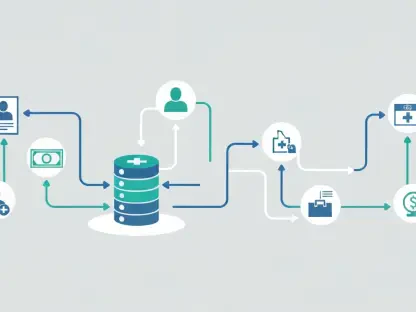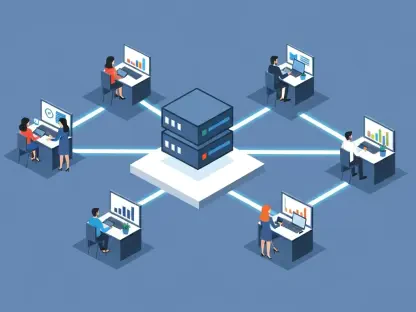In the rapidly evolving landscape of artificial intelligence (AI), businesses are constantly seeking ways to optimize their AI strategies. Two key technologies, Edge Computing and Cloud AI, offer distinct advantages that can be leveraged to enhance AI capabilities. Understanding how to balance these technologies is crucial for achieving strategic goals and driving innovation. Companies need to assess their specific needs and determine the right balance to stay competitive.
Understanding Edge Computing and Cloud AI
Defining Edge Computing
Edge Computing is a distributed computing paradigm that processes data closer to the source, reducing latency and bandwidth costs. By executing workloads near the data source rather than on centralized cloud servers, edge computing enhances the speed and efficiency of digital experiences. This approach is vital for real-time applications like autonomous vehicles, industrial automation, and smart cities, where immediate decision-making is essential. Edge Computing infrastructure can vary from dedicated edge servers to a network of distributed edge servers and Internet of Things (IoT) devices for local data processing and analysis.
The main advantage of Edge Computing is its ability to process data locally, which is crucial for applications requiring instant decisions. By reducing the time it takes for data to travel to a central server and back, edge computing significantly reduces latency. This makes it ideal for scenarios where response time is critical, such as in industrial automation or autonomous vehicles. Additionally, by processing data at the edge, businesses can reduce bandwidth costs and alleviate network congestion, which is beneficial for managing large volumes of data generated by IoT devices. Overall, Edge Computing offers significant benefits for improving real-time processing and operational efficiency.
Defining Cloud AI
Cloud AI combines AI with cloud computing to provide scalable services for tasks such as deep learning and large-scale analytics. Leveraging the vast computational resources of centralized cloud data centers, Cloud AI supports extensive data processing and intelligent decision-making. Cloud-based AI enables businesses to predict situations, learn from gathered data, and solve problems proactively, supporting various innovative use cases. The centralized nature of Cloud AI allows for the development and deployment of sophisticated AI models that require significant computational power and storage capacity.
One of the key advantages of Cloud AI is its dynamic scalability, which allows businesses to handle fluctuating workloads without the need for additional on-premises infrastructure. This flexibility is crucial for managing large-scale AI tasks and deep learning models, enhancing the capability to process extensive datasets effectively. Moreover, Cloud AI provides access to vast amounts of data stored in centralized clouds, which is essential for training accurate predictive models and enhancing intelligent decision-making capabilities. By leveraging Cloud AI, businesses can achieve superior computational resources, scalability, and efficient management of extensive data processing tasks.
Key Advantages of Each Technology
Flexibility and Scalability
Cloud AI offers dynamic scalability, allowing businesses to handle fluctuating workloads without additional on-premises infrastructure. This flexibility is crucial for managing large-scale AI tasks efficiently. Cloud AI platforms provide the ability to scale up or down based on demand, ensuring that businesses can optimize resources and costs. This is particularly beneficial for companies that need to process extensive datasets and execute deep learning models, as they can leverage the vast computational power of cloud data centers without the need for significant capital investment.
The significant computational resources of Cloud AI platforms make them suitable for intensive tasks like deep learning. Centralized cloud storage also enables access to vast datasets, essential for accurate predictive models and intelligent decision-making. By utilizing Cloud AI, businesses can take advantage of advanced analytics and data processing capabilities, offering insights that drive strategic decisions and improve operational efficiency. The ability to access and analyze large datasets in the cloud enhances the accuracy and effectiveness of AI models, leading to better outcomes and innovations across various industries.
Processing Power and Data Access
The significant computational resources of Cloud AI platforms make them suitable for intensive tasks like deep learning. Centralized cloud storage also enables access to vast datasets, essential for accurate predictive models and intelligent decision-making. This centralized approach allows for the development and deployment of sophisticated AI models that require substantial processing power and storage capacity. By leveraging the capabilities of Cloud AI, businesses can achieve superior performance in handling large-scale data processing tasks, driving innovation and improving decision-making accuracy.
Cloud AI’s ability to process and analyze extensive datasets is critical for developing accurate predictive models and enhancing intelligent decision-making capabilities. The centralized nature of cloud storage allows businesses to gather and consolidate large amounts of data, providing a comprehensive view of patterns and trends. This data-driven approach enables companies to make informed decisions, optimize operations, and identify new opportunities for growth. Additionally, the scalability and flexibility of Cloud AI platforms ensure that businesses can efficiently manage fluctuating workload demands, enhancing overall efficiency and performance.
Real-Time Decision-Making and Cost Efficiency
Latency and Real-Time Processing
Edge Computing reduces latency by processing data locally, which is critical for applications requiring instant decisions, such as IoT devices and autonomous systems. By bringing data processing closer to the source, edge computing minimizes the time it takes for data to travel to a central server and back, significantly reducing response time. This local processing capability enhances the speed and efficiency of digital experiences, making it ideal for applications that require real-time decision-making and immediate action. Autonomous vehicles, industrial automation, and smart city initiatives are just a few examples of where edge computing’s latency reduction plays a crucial role.
The ability to process data in real time is essential for numerous industries and applications. For instance, in manufacturing, real-time data processing can improve operational efficiency, reduce downtime, and enhance product quality by enabling immediate adjustments to production processes. In healthcare, real-time data processing can facilitate prompt diagnosis and treatment, thereby improving patient outcomes. By leveraging edge computing for real-time processing, businesses can gain a competitive edge by making faster, more informed decisions that optimize operations and drive innovation.
Cost Implications
By transmitting only essential data to the cloud, Edge Computing can lower bandwidth expenses and reduce network congestion. This localized approach minimizes the need for extensive cloud storage, leading to cost savings. By processing data at the edge, businesses can significantly reduce the volume of data that needs to be transmitted to centralized cloud servers, which lowers bandwidth costs and alleviates network congestion. This localized processing ensures that only the most critical data is sent to the cloud for further analysis and storage, optimizing resource utilization and reducing overall expenses.
The cost savings associated with edge computing are particularly beneficial for businesses managing large volumes of data generated by IoT devices. In industries such as manufacturing, logistics, and healthcare, where IoT devices generate vast amounts of data, edge computing can help optimize data management and reduce operational costs. By processing data locally, businesses can improve efficiency, reduce latency, and achieve cost savings, making edge computing a valuable component of their AI strategy. Moreover, the reduction in network congestion resulting from localized data processing can enhance overall network performance, ensuring more reliable and efficient operations.
Security and Privacy Considerations
Enhancing Security
Edge Computing maintains sensitive data on-premises, reducing exposure to cyber threats and enhancing regulatory compliance. By processing data locally, businesses can ensure that sensitive information remains within their control, reducing the risk of data breaches and unauthorized access. Additionally, local storage of data provides an additional layer of security compared to data transmission required in Cloud AI, which can be vulnerable to interception and tampering. This enhanced security is particularly important for industries dealing with sensitive data, such as finance, healthcare, and government.
The local processing and storage of data with edge computing enable businesses to implement robust security measures tailored to their specific needs. This includes securing data at the edge devices, encrypting data during transmission, and implementing stringent access controls. By taking a proactive approach to data security, businesses can protect sensitive information, ensure regulatory compliance, and build trust with customers and stakeholders. Overall, edge computing’s focus on enhancing security is a critical advantage for businesses seeking to safeguard their data and mitigate potential cyber threats.
Privacy Benefits
Processing data locally with Edge Computing ensures that sensitive information remains within the organization’s control, addressing privacy concerns and meeting regulatory requirements more effectively. By keeping data on-premises, businesses can implement privacy measures that comply with industry regulations and standards, reducing the risk of data exposure and ensuring customer trust. This approach is particularly important in industries such as healthcare and finance, where strict privacy regulations mandate the protection of sensitive information.
Local data processing with edge computing also enables businesses to maintain greater transparency and control over how data is used and shared. By limiting the transmission of sensitive data to external cloud servers, organizations can minimize the risk of data leaks and unauthorized access. This approach not only enhances privacy but also supports compliance with data protection regulations such as the General Data Protection Regulation (GDPR) and the California Consumer Privacy Act (CCPA). By leveraging edge computing for local data processing, businesses can address privacy concerns, ensure regulatory compliance, and build a foundation of trust with customers and stakeholders.
Combining Edge Computing and Cloud AI
Hybrid Approach
A hybrid approach that combines Edge Computing and Cloud AI can maximize AI potential. By leveraging the strengths of both technologies, businesses can achieve real-time analytics and personalized experiences while maintaining cost efficiency and security. This hybrid model allows for the seamless integration of local data processing at the edge with the extensive computational resources and storage capabilities of the cloud. By strategically distributing workloads between edge and cloud environments, businesses can optimize performance, reduce latency, and enhance overall efficiency.
The hybrid approach enables businesses to take advantage of real-time processing capabilities offered by edge computing while leveraging the advanced data analytics and machine learning models available through cloud AI. For example, data collected and processed at the edge can be transmitted to the cloud for further analysis, enabling businesses to gain deeper insights and make more informed decisions. This combination of edge and cloud technologies ensures that businesses can address the specific requirements of various applications, from real-time decision-making to large-scale data processing, ultimately driving innovation and improving operational outcomes.
Strategic Integration
Carefully assessing specific business needs and evaluating the scalability, efficiency, and flexibility of these technologies will help in selecting the right balance. This strategic integration fosters innovation and drives real-time analytics across various applications. By understanding the unique advantages and limitations of edge computing and cloud AI, businesses can create a balanced approach that enhances real-time capabilities and insightful decision-making. Conducting a thorough assessment of current infrastructure, data processing requirements, and future growth plans is essential for determining the optimal distribution of workloads between edge and cloud environments.
Strategic integration also involves considering the long-term implications of adopting a hybrid model. Businesses need to evaluate the potential for scalability, the impact on operational efficiency, and the alignment with overall strategic goals. By taking a holistic approach to integrating edge computing and cloud AI, organizations can ensure that their AI strategies remain adaptable and resilient in the face of evolving technological advancements. Ultimately, the successful integration of these technologies will enable businesses to optimize AI capabilities, drive innovation, and achieve their strategic objectives.
Conclusion
In the swiftly advancing world of artificial intelligence (AI), businesses are urgently seeking methods to refine their AI strategies. Two significant technologies, Edge Computing and Cloud AI, provide unique advantages that can boost AI capabilities. Edge Computing allows for processing data closer to the source, reducing latency and enhancing real-time decision-making. In contrast, Cloud AI offers massive computational power and storage, enabling complex analyses and large-scale data processing. Balancing these two technologies is essential for companies aiming to achieve their strategic objectives and foster innovation. To stay competitive, businesses must carefully evaluate their specific requirements and determine the optimal mix of Edge Computing and Cloud AI. This balanced approach ensures that they can capitalize on the strengths of both technologies, thereby driving growth and maintaining a competitive edge in a rapidly shifting market. The combination of these two AI technologies can significantly enhance operational efficiency, improve customer experiences, and spur technological innovation.









